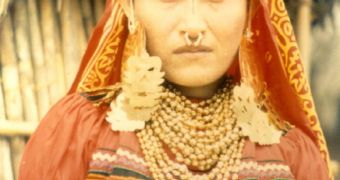The Cuna Indians inhabit the San Blas Archipelago, a group of 300 islets located off the Caribbean coast of Panama, on a length of 150 km (95 mi). Only the 50 largest islands are inhabited. The maximum height of the islands is of 200 m (666 ft) and they are covered by lush tropical forests. But, despite their beauty, tranquility and clear sea, the islands have a great problem: they are devoid of drinking water. Only the Pinos Island has wells.
When Spaniards stepped on the land of Panama (the expedition led by Vasco Nunez de Balboa in 1511), the Cuna Indians lived on the mainland, on the Darien area. The Cunas fought fierce battles against the Spaniards and turned into the target of violent persecutions. During the 18th century, along with the hostile relation with the Spaniards, the Cunas were affected by malaria epidemics that decimated their numbers. The remaining population retreated to the San Blas, where exactly the lack of freshwater makes the malaria transmitting mosquitoes scarce. The archipelago also offered a total isolation from the Whites.
Cuna villages are made at the sea shore, as those waters are calm and storms rarely occur. Many houses were palafitos (built on posts planted on the sea floor). Over the posts, the Cunas made a platform the hut was raised on. The hut was rectangular, with walls made of wood and bark and the roof on two slopes was made of grass, straw and branches. To ascend into the house, ladders made of branches or reed were used. On the higher part of the hut, the barn was located. A small distinct hut was used as kitchen. Still, most of the village was built on firm ground, at the protective shadow of the palm trees.
In the Cuna belief system, the shamans intent to dominate the evil spirits, inhabiting rocks, trees and storms. The large green iguana is related to the spirits, and the Cunas use its tail and feet for making magic filters.
This is made via rituals and singing. Diseases are put on spells, and in this case, the shaman of the village, which receives a large honorary, must be asked for help. That's why each Cuna family has one to several magic wooden figurines, cut into the shape of a woman or man, with clothes of the White man, which are said to be unerring in treating diseases, once the right magic formula is applied on them. This was the Cuna religion until several decades ago. Christian missionaries could not reach their goals, as the Cunas did not allow any stranger to spend the night on the islands.
The Cunas are among the shortest Amerindians: 1.5 m (5 ft) is the average height for men, and 1.46 m (4.8 ft) for women. These people have robust bodies, short limbs, wide heads and flattened faces; the skin is light dark. One of the strange issues amongst the Cunas is the large number of albino individuals: 1 albino to 100 Cunas. In the rest of the human populations, this number is much lower. Albino individuals have a great disadvantage in the tropical climes, as their skin is delicate to sunlight, but in the Cuna society they are considered endowed with magical powers, being sons of the Moon, and they are highly respected.
Cuna women wear cotton skirts of vivid colors, reaching down to their ankles, and complicated beautiful blouses, called molas, made by applying tags of fabrics of various colors, carefully sewed, over a bed of velvet or other material. The results are amazing mosaics, with complicated animal, plant, human and geometrical images. The Cunas know spinning and weaving, but they prefer buying the fabrics from the mainland; from these fabrics, the women make the molas.
The Cuna women also wear many brightly-colored glass bead collars, bracelets, and golden earrings in the ears and nose. The hair is cut short, forming a fringe over the forehead. They use to paint white and black drawings on their faces. On the wrists and ankles, Cuna women wear extremely tight fabric or cord bands, so that the skin forms ledges beneath and below.
The islands are poor in fauna, and the Cuna hunters have to go on the mainland for hunting peccaries, tapirs, monkeys, agouti, deer, sloths and birds. Hunting is made using traps, blowpipes, bow and arrows, spears, but today guns are preferred.
The rich Cunas possess horses; this is a luxury item, as on these islands their utility is less significant. The Cunas keep domestic birds, pigs and dogs for hunting. Agriculture is a difficult task of San Blas, because of the lack of water, but the Cunas use to cultivate larger patches on the neighboring mainland and smaller ones on the islands. The main crops are corn, beans, sugarcane and tobacco. Still, on the islands they have plantations of bananas, cocoa trees and coconut trees. Women grind corn in large wooden mortars. Smashed corn, bananas and sugarcane juice are used for making a type of alcoholic beverage, consumed during great festivities. Today, the Cunas prefer rum.
Men are charged with harvesting fruits, hunting and fishing. Fishing is practiced on the banks or from the boats, using nets, baskets, spears and toothed harpoons. Lures are used for attracting large sea turtles to the especially placed nets.
Each day, early in the morning, the Cuna girls go to the neighboring coasts on wide shallow boats. They go on distances up to 500 m (0.3 mi) searching for water, stored in large pots. Sometimes, they make several voyages daily.
The Cunas are joyful, expansive people. Their music is played at squash maracas, panpipes and wood drums covered with skin patches, and in the evening they get together for dancing and singing.

 14 DAY TRIAL //
14 DAY TRIAL //